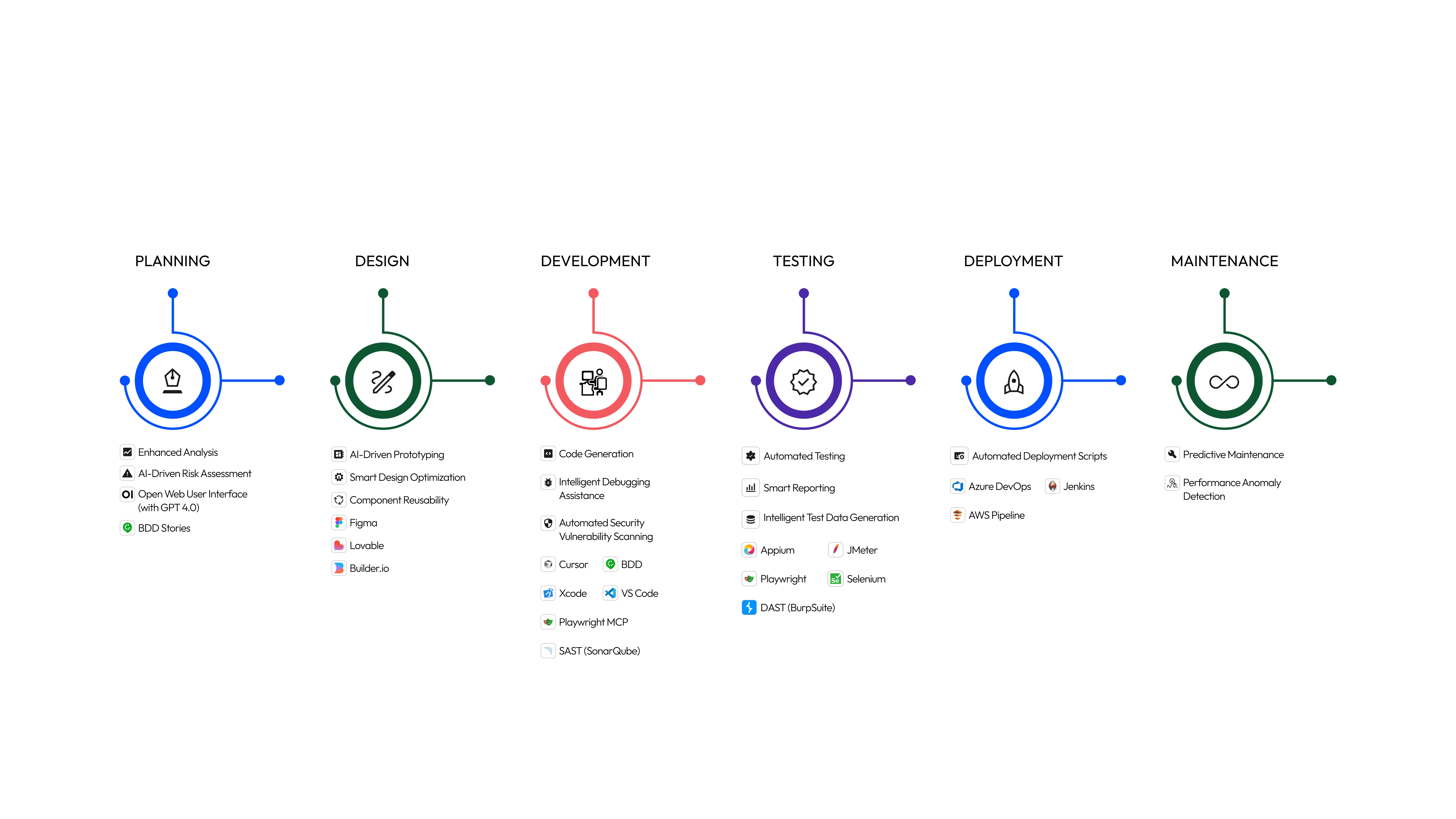Speed, accuracy, and quality are no longer optional—your users expect them. Generative AI (GenAI) is enabling a smarter, faster SDLC by embedding intelligence into every stage. This isn’t just about bolting AI onto existing processes; it’s about re-engineering how software is built so that quality isn’t an afterthought.
Generative AI (GenAI) is fundamentally changing how we build software, but this isn’t about a new tool; it’s about a new competitive edge. By embedding intelligence throughout the software development lifecycle (SDLC), we can achieve a strategic paradigm shift: moving from a reactive model of fixing problems to a proactive one of preventing them entirely. This is the key to accelerating innovation and driving tangible business value.
The Shift Is Real: From Fixing Bugs to Avoiding Them Altogether
The traditional software process is filled with costly delays and rework. Misunderstood requirements, late-stage bugs, and last-minute surprises can stall releases and increase costs exponentially – the cost to fix a bug grows exponentially as software progresses through the lifecycle. Fixing those bugs post-release can cost up to 100× more than if caught during design.
Generative AI, paired with a shift-left mindset, turns this on its head. By injecting intelligence early in requirement analysis and design, teams move from detecting bugs to preventing them altogether. Instead of waiting for a bug to appear, AI helps identify gaps, inconsistencies, and potential failure points before any code is written. This is how you move from playing catch-up to leading the market.
- 70% of defects originate during the planning and design phases.
- Catching them early avoids costly rework and release delays.
By clarifying requirements and designs upfront, GenAI helps teams avoid downstream issues. A proactive, AI-augmented process ensures that by the time development starts, requirements are crystal-clear and potential failure points have been spotted. QA shifts from a backloaded task to a continuous quality guide, leading to fewer surprises and more confident releases.
How an AI-Powered SDLC Drives Business Impact?
An AI-powered SDLC is more than a technical upgrade; it’s a strategic investment with clear business returns. Here’s how GenAI adds value across every phase of your operation:
1. Smarter Requirements = Fewer Surprises
Requirements set the tone for everything that follows—but they’re often vague or inconsistent. GenAI steps in as a real-time analyst, parsing meeting notes to spot ambiguities, flag contradictions, and generate more precise specs. It can also draft user stories or acceptance criteria from natural language inputs, aligning everyone early. Teams using Behavior-Driven Development (BDD) can even auto-generate testable formats from the start.
- Clearer specs: AI fills gaps and standardizes language to reduce misinterpretation.
- Faster story creation: Drafts user stories and acceptance criteria from discussions.
- Fewer logic errors: Flags contradictions before they reach development.
By catching issues early, GenAI reduces costly rework and keeps projects on track.
2. Design with Intelligence Built In
Design is where ideas take shape—and mistakes here ripple downstream. GenAI accelerates UX/UI workflows by suggesting design patterns, flagging accessibility issues, and generating variants tailored to user intent. It even checks adherence to WCAG and brand guidelines before handoff. On the technical side, GenAI proposes architectures and generates wireframes or data models to avoid over-engineering.
- Faster prototyping with AI-suggested layouts
- Built-in compliance (e.g., color contrast, font size)
- Seamless design-to-dev handoff with auto-generated style guides and code snippets
3. Development: Shift-Left in Action
GenAI transforms the developer experience by drafting code, generating unit tests, and reviewing quality in real-time. Developers can describe intent in natural language and receive ready-to-edit code, reducing boilerplate and errors.
- Auto-generated tests tied to user stories
- Real-time feedback on code quality, security, and bugs
- 2× faster coding productivity without compromising quality
4. Continuous Testing That Keeps Pace
Testing is no longer a bottleneck. GenAI reads requirements, generates test cases, and runs them across environments. It detects flaky tests, analyzes logs, and even generates test data on the fly.
- 50–60% faster test generation and execution
- Prioritized regression based on risk profiles
- Issues resolved during design/dev, not post-deploy (IBM: ~25% reduction in unit test generation time)
5. Predictive CI/CD Pipelines
GenAI turns reactive CI/CD into a predictive engine. It flags risky commits, forecasts failures, and self-heals pipeline errors. It even scales infrastructure based on workload forecasts.
- Flags unstable builds pre-merge
- Reduces rollbacks with predictive deployment analysis
- Optimizes resource allocation to reduce cloud costs and runtime
The Net Solutions Process
At Net Solutions, we don’t just talk about these changes—we’ve engineered them into our core process. Our approach combines a “shift-left” DevOps culture with the power of GenAI to make quality a built-in feature, not an afterthought.
Our Engineering Process
As illustrated in the “Our Engineering Process – DevOps” framework, we’ve architected a tightly integrated workflow that brings together requirement precision, design clarity, developer agility, and QA rigor, all underpinned by intelligent automation.

1. Requirement Analysis – From Meetings to Models
- Requirement Translation & Explanation, tools like GMeet (Transcribing and Notes Creation), and Open Web User Interface capture and formalize requirements early on.
- AI actively parses notes and identifies ambiguities, inconsistencies, or missing context—making specifications stronger before development starts.
- Tools like OWUI are utilized with Custom Instructions to generate BDD Stories
2. UI/UX/FED – Designing Delight
- We use Figma, Lovable, and Builder.io to turn insights into engaging user journeys.
- These prototypes feed directly into development, ensuring continuity.
- AI suggests UI patterns and checks accessibility/compliance.
- Much of the design process is to curate the best design for clients, but AI surely helps expedite this process.
3. Development – BDD-Driven, AI-Powered, Shift Left in Action
- Core tools: Cursor, VS Code/ Cline, Playwright MCP, and Xcode are used extensively to develop code for BDD Stories.
- These tools (AI Agents) support quicker implementation, allow consistent quality implementation, and shorten the “idea-to-customer” cycle.
- BDD isn’t just documentation—it drives automated test case generation, drastically reducing manual test creation effort.
- AI translates BDD into Playwright scripts, surfaces defects early (via SonarQube), and supports shift-left functional test generation.
4. Quality Assurance
- QA isn’t an afterthought—it’s integrated right from the design phase.
- Tools: Selenium, Appium, JMeter, Playwright, BurpSuite help in assuring the quality of the product.
- AI accelerates test generation by up to 60%, as seen in Schaeffler’s benchmark.
- AI-assisted QA tools dynamically generate and execute test scripts while analyzing test coverage, flakiness, and performance anomalies.
5. CI/CD: From Push to Production, Seamlessly
- Azure DevOps, Jenkins, and AWS Pipelines orchestrate our automated build-test-deploy cycle.
- AI predicts build failures, auto-corrects flaky steps, and ensures optimal resource usage.
- This results in reliable, fast, and low-risk production releases.
6. Building AI You Can Trust: NIST AI RMF in Action
Responsible AI isn’t just good practice—it’s essential for long-term success. At Net Solutions, we embed NIST AI Risk Management Framework (AI RMF) principles into every GenAI-enabled SDLC.
- AI Governance Committees & Policy Oversight
- Context Mapping Workshops & Use Case Inventories
- Real-Time Monitoring with AWS CloudWatch, DataDog
- Fairness Testing, Adversarial Scenarios & Human-in-the-Loop Controls
- Automated Compliance via Drata, Incident Playbooks with Zoho
Whether you’re building internal AI tools or customer-facing applications, we help ensure they’re safe, ethical, explainable, and auditable—every step of the way.
Trust isn’t built by accident—it’s engineered into every layer.
Key Highlights:
- Accelerated shift-left testing with bidirectional automation between requirements and tests.
- Automated traceability from System Requirements → Functional Test, and back from Qualification Tests.
- AI generates test cases from requirements, reduces manual QA effort, and connects early-stage decisions to end-stage validations.
Why This Matters: Measurable Benefits
The Integration of Generative AI and Shift-Left DevOps Delivers Tangible Business Value
| Benefit | Impact |
|---|---|
| Faster Time-to-Market | AI automation compresses development & testing cycles |
| Improved Software Quality | Early-stage detection eliminates 80%+ of critical issues |
| Cost Savings | Fixing bugs pre-code is 10x cheaper than in production |
| Intelligent Decisions | AI insights support proactive risk mitigation |
| Developer Efficiency | Less time debugging, more time building features |
| Continuous Optimization | AI learns from historical projects and improves future pipelines |
This is not evolution, it’s a revolution. By combining Generative AI, BDD, and Shift-Left DevOps, we don’t just develop software; we also deliver it. We engineer quality from day one. In an era where speed and precision define market leaders, our AI-powered engineering ecosystem ensures we deliver faster, better, and smarter every single time.
By combining a shift-left, BDD-first DevOps framework with AI-driven automation, we help you build better software faster, engineering quality from day one, and eliminating surprises on release day.



